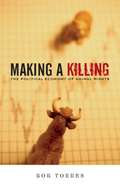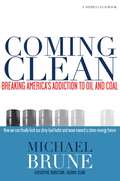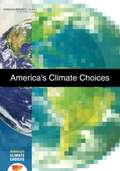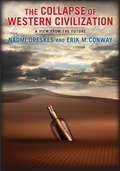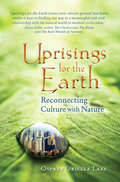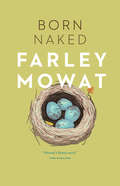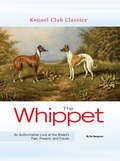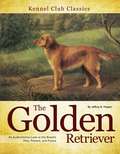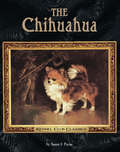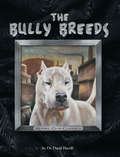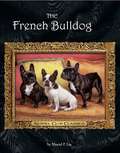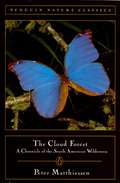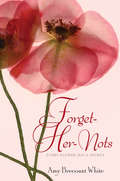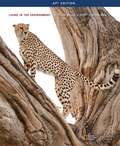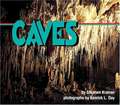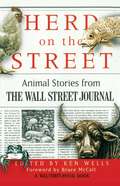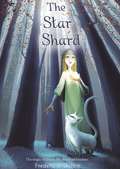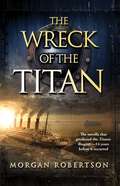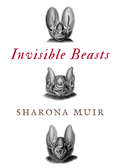- Table View
- List View
Making A Killing
by Bob TorresSuggest to the average leftist that animals should be part of broader liberation struggles and--once they stop laughing--you'll find yourself casually dismissed. With a focus on labor, property, and the life of commodities, Making a Killing contains key insights into the broad nature of domination, power, and hierarchy. It explores the intersections between human and animal oppressions in relation to the exploitative dynamics of capitalism. Combining nuts-and-bolts Marxist political economy, a pluralistic anarchist critique, as well as a searing assessment of the animal rights movement, Bob Torres challenges conventional anti-capitalist thinking and convincingly advocates for the abolition of animals in industry--and on the dinner plate.Making A Killing is sure to spark wide debate in the animal rights and anarchist movements for years to come.Table Of Contents:I Taking Equality SeriouslyII Chained CommoditiesIII Property, Violence, and the Roots of OppressionIV Animal Rights and WrongsV You Cannot Buy the RevolutionAdvance praise for Making A Killing"Bob Torres' Making a Killing draws a very straight line between capitalism and the oppressive system of animal agribusiness. Drawing from social anarchist theory, Torres provides a convincing argument that in order to fight animal exploitation, we must also fight capitalism and, in doing so, animal rights activists will need to reconsider their methods and redirect their focus. While his critiques of the animal rights movements' large organizations may not earn him friends in high places, such considerations are crucial to keeping the movement on track and for preventing stagnation.Making a Killing is an important work from a new voice in animal advocacy that will surely spark heated discussions amongst activists from all corners of the movement."--Ryan MacMichael, vegblog.org"In Making A Killing: The Political Economy of Animal Rights, Bob Torres takes an important and timely look at the animal rights movement, calling for a synthetic approach to all oppression, human and animal. His analytical framework draws together Marxism, social anarchist theory, and an abolitionist approach to animal rights to provide a timely social analysis that will no doubt have profound effects on the animal rights movement literature."--Gary L. FrancioneDistinguished Professor of Law, Rutgers University"Bob Torres's socioeconomic analysis of nonhuman animal use is a welcome and important addition to the understanding of human-nonhuman relations at the beginning of the 21st century. In particular, Making a Killing, makes vital a contribution to understanding the role of the property status of animals and the continuing strength of various welfarist positions on the ethics--and indeed the economics--of the human utilisation of other animals. Making a Killing will become required reading for social scientists and others interested in modern social movements and the socioeconomic forces that shape their activities and their claims-making."--Dr. Roger Yates, Lecturer in sociology at University College, Dublin, Republic of Ireland"This is the book I've been waiting for. Making A Killing is a rare and powerful example of first-rate scholarship, a searing critique, and lively declaration of the rights of animals and humans. You will walk away from this book with a clear understanding as to why social justice movements for people must take animal rights seriously, and vice versa. Bob Torres has forever deepened my thinking about these relationships."--David Naguib Pellow, vegetarian, animal rights and anti-racist activist, and Professor of Ethnic Studies, University of California, San Diego; and author of Garbage Wars: The Struggle for Environmental Justice in Chicago and Resisting Global Toxics: Transnational Movements for Environmental JusticeBob Torres is assistant professor of sociology at St. Lawrence University, received his PhD from Cornell, and is co-author of Vegan Freak: Being Vegan in a Non-Vegan World. His writings have appeared in Critical Sociology, The Journal of Latinos and Education...
Coming Clean
by Michael BruneThe catastrophic release of oil into the Gulf of Mexico by BP's Deepwater Horizon well has been a wake-up call, bringing home to Americans in a very personal way-more powerfully than statistics on peak oil or global warming-the message that we must end our destructive dependence on fossil fuels. We want to move our country toward a clean-energy future, and this book provides a road map for how to get there.Author Michael Brune, executive director of the Sierra Club and former head of Rainforest Action Network, distills all his activist skills and passion into this handbook. He shows us how we, as motivated citizens, can put our convictions into practice and strategically pressure corporations and our government to change their energy priorities. His vivid reports track the myriad ways our thirst for ever-scarcer oil and coal harms communities like those along the Gulf coast, corrupts policy and finance, and wreaks havoc on the Earth and its climate. He also describes the most promising developments in renewables, biofuels, and efficient design. In a new afterword to this edition, Brune recounts his personal experiences working on the scene in the Gulf region, and offers an inspiring vision of the clean-energy future within our reach.
A Review of the Use of Science and Adaptive Management in California's Draft Bay Delta Conservation Plan
by Technology Board Water ScienceThe San Francisco Bay Delta Estuary is a large, complex estuarine ecosystem in California. It has been substantially altered by dikes, levees, channelization, pumps, human development, introduced species, dams on its tributary streams and contaminants. The Delta supplies water from the state's wetter northern regions to the drier southern regions and also serves as habitat for many species, some of which are threatened and endangered. The restoration of water exacerbated tensions over water allocation in recent years, and have led to various attempts to develop comprehensive plans to provide reliable water supplies and to protect the ecosystem. One of these plans is the Bay Delta Conservation Plan (BDCP). The report, A Review of the Use of Science and Adaptive Management in California's Draft Bay Delta Conservation Plan, determines that the plan is incomplete in a number of important areas and takes this opportunity to identify key scientific and structural gaps that, if addressed, could lead to a more successful and comprehensive final BDCP. The plan is missing the type of structure usually associated with current planning methods in which the goals and objectives are specified, alternative measure for achieving the objectives are introduced and analyzed, and a course of action in identified based on analytical optimization of economic, social, and environmental factors. Yet the panel underscores the importance of a credible and a robust BDCP in addressing the various water management problems that beset the Delta. A stronger, more complete, and more scientifically credible BDCP that effectively integrates and utilizes science could indeed pave the way toward the next generation of solutions to California's chronic water problems.
America's Climate Choices
by Board on Atmospheric Sciences ClimateClimate change is occurring. It is very likely caused by the emission of greenhouse gases from human activities, and poses significant risks for a range of human and natural systems. And these emissions continue to increase, which will result in further change and greater risks. America's Climate Choices makes the case that the environmental, economic, and humanitarian risks posed by climate change indicate a pressing need for substantial action now to limit the magnitude of climate change and to prepare for adapting to its impacts. Although there is some uncertainty about future risk, acting now will reduce the risks posed by climate change and the pressure to make larger, more rapid, and potentially more expensive reductions later. Most actions taken to reduce vulnerability to climate change impacts are common sense investments that will offer protection against natural climate variations and extreme events. In addition, crucial investment decisions made now about equipment and infrastructure can "lock in" commitments to greenhouse gas emissions for decades to come. Finally, while it may be possible to scale back or reverse many responses to climate change, it is difficult or impossible to "undo" climate change, once manifested. Current efforts of local, state, and private-sector actors are important, but not likely to yield progress comparable to what could be achieved with the addition of strong federal policies that establish coherent national goals and incentives, and that promote strong U. S. engagement in international-level response efforts. The inherent complexities and uncertainties of climate change are best met by applying an iterative risk management framework and making efforts to significantly reduce greenhouse gas emissions; prepare for adapting to impacts; invest in scientific research, technology development, and information systems; and facilitate engagement between scientific and technical experts and the many types of stakeholders making America's climate choices.
Transnational Climate Change Governance
by Stacy D. Vandeveer Daniel Compagnon Harriet Bulkeley Thomas Hale Peter Newell Charles Roger Harriet Bulkeley Liliana B. Andonova Michele M. Betsill Daniel Compagnon Thomas Hale Matthew J. Hoffmann Peter Newell Matthew Paterson Charles Roger Liliana B. Andonova Michele M. Betsill Matthew J. Hoffmann Matthew PatersonThe world of climate politics is increasingly no longer confined to the activities of national governments and international negotiations. Critical to this transformation of the politics of climate change has been the emergence of new forms of transnational governance that cut across traditional state-based jurisdictions and operate across public and private divides. This book provides the first comprehensive, cutting-edge account of the world of transnational climate change governance. Co-authored by a team of the world's leading experts in the field and based on a survey of sixty case studies, the book traces the emergence, nature and consequences of this phenomenon, and assesses the implications for the field of global environmental politics. It will prove invaluable for researchers, graduate students and policy makers in climate change, political science, international relations, human geography, sociology and ecological economics.
The Collapse of Western Civilization
by Naomi Oreskes Erik M. ConwayThe year is 2393, and a senior scholar of the Second People's Republic of China presents a gripping and deeply disturbing account of how the children of the Enlightenment, the political and economic elites of the so-called advanced industrial societies, entered into a Penumbral period in the early decades of the twenty-first century, a time when sound science and rational discourse about global change were prohibited and clear warnings of climate catastrophe were ignored. <P><P>What ensues when soaring temperatures, rising sea levels, drought, and mass migrations disrupt the global governmental and economic regimes? <P><P>The Great Collapse of 2093.This work is an important title that will change how readers look at the world. Dramatizing climate change in ways traditional nonfiction cannot, this inventive, at times humorous work reasserts the importance of scientists and the work they do and reveals the self-serving interests of the so called "carbon industrial complex" that have turned the practice of sound science into political fodder. <P><P>The authors conclude with a critique of the philosophical frameworks, most notably neo-liberalism, that do their part to hasten civilization's demise. <P><P>Based on sound scholarship yet unafraid to tilt at sacred cows in both science and policy, this book provides a welcome moment of clarity amid the cacophony of climate change literature. It includes a lexicon of historical and scientific terms that enriches the narrative and an interview with the authors.
Uprisings for the Earth
by Osprey Orielle LakeWe face a serious global challenge with over half the world's population living in urban environments -- mostly disconnected from the natural world. This represents a key element of the serious economic, social and environmental crises looming today. Osprey Orielle Lake, a lifelong advocate for the environment and cultural transformation, weaves together history, science, culture, governance, spirituality, and the arts to map out an integrated approach to working in partnership with nature while creating a more just and sustainable future. Lake argues that "a culture or civilization bereft of its connection to nature will not be sustainable -- the decades since Rachel Carson wrote Silent Spring have clearly shown us this. We will need to reconnect with the rhythms of the natural world in contemporary society to generate inner and outer resilience, and to move through the uncertain times ahead."Lake offers a frank inquiry into a variety of causes leading to our current global peril and also provides a deep well of hope and profound insight. Each chapter poetically emerges from a specific geographical region and, with the lively tone of place-based literature, creates a tapestry composed of personal experiences, nature writing, environmental awareness and cultural criticism. Incorporating historical and contemporary voices from many fields of endeavor, Lake encourages people to understand the legacy of information we already possess.Uprisings delves into a new kinship with nature while acknowledging the treasures of urban life and the unique and valuable stake each person has in resolving critical and timely challenges. Whether you are a parent, an activist, a health care professional, a newcomer to recycling, a politician, a lover of nature writing, an historian, or searching for recovery from apathy or hopelessness, consider this book required reading!
Born Naked
by Farley MowatFarley Mowat's outrageous memoir begins with his unlikely conception in a canoe and continues to his boyhood fascination with creatures of the natural world and on to his youthful rambles and adventures. To his immense pleasure and his parents' dismay, he adopted various beasts (whom he affectionately calls "The Others") as roomates. In this boyhood memoir, he recounts the exploits of this second family, who have been the subjects of many of his beloved books for young readers. This is the tale of a mischievous, immensely gifted young naturalist, recounted with the wisdom, humour and grown-up perspective of a very talented writer.
The Whippet
by Bo BengtsonFifth in the Kennel Club Classics breed series, The Whippet, written by renowned Whippet breeder, judge and historian Bo Bengtson, is the bible on the Whippet, one of the world's most popular and beloved purebred dogs. This book's detailed chapters on everything from the history of the breed to the breed's accomplishments in dog shows around world to the Whippet's participation in racing and coursing events make it the most important and beautiful book ever published on the Whippet. With hundreds of vintage and modern photographs, this book is a must-have for every whippet owner.
Golden Retriever
by Jeffrey G. PepperFourth in the Kennel Club Books' Classics series, The Golden Retriever recognizes the ever-popular all-American breed in this one spectacular volume. Written by author, breeder, and judge, Jeffrey G. Pepper, this book's engaging chapters on everything from the breed's accomplishments in performance events, to their participation as service dogs make it much more than just "another breed book." With more than 100 vintage and modern photographs of the breed, this book is a must-have for every Golden owner.
The Chihuahua
by Susan PayneThird in the Kennel Club Books' Classics series, The Chihuahua recognizes the ever-popular pequeño perrito in one spectacular volume. Written by author, breeder, and handler, Susan Payne, this book's engaging chapters on everything from the breed's accomplishments in performance events, to their participation as service dogs make it much more than just "another breed book." With more than 150 vintage and modern photographs of the breed, this book is a must-have for every Chihuahua owner.
The Bully Breeds
by David HarrisDiscover the real bully dogs and the truth about these often-misunderstood yet ever-popular canines. The whole fraternity of bully breed owners and devotees will revel in this long-overdue celebration of the six bull-and-terrier dogs that are the focus of this Kennel Club Classic edition.
The French Bulldog
by Muriel P. LeeThe first title in the exciting new Kennel Club Classics series is French Bulldog, an elaborate photographic celebration of one of the dog world's most beloved breeds. Written and compiled by Just Frenchies editor Muriel P. Lee, this 200-page hardcover volume features articles on the breed's history by Anne M. Hier, breed health by Janice Grebe, judging by Virginia Rowland, the breed in England and France by Penny Rankine-Parsons, the breed in Australia and New Zealand by Michael Rosser, and working dogs by Bette and Manda Kaplan. No Frenchie lover will live without this volume on their coffee table!
Cloud Forest: A Chronicle of the South American Wilderness
by Peter MatthiessenPeter Matthiessen crisscrossed 10,000 miles of the South American wilderness, from the Amazon rain forests to Machu Picchu, high in the Andes, down to Tierra del Fuego and back. He followed the trails of old explorers, encountered river bandits, wild tribesmen, and the evidence of ancient ruins, and discovered fossils in the depths of the Peruvian jungle. The Cloud Forest is his incisive, wry report of his expedition into this vast world to the south.
Forget-Her-Nots
by Amy Brecount WhiteSomething-some power-is blooming inside Laurel. She can use flowers to do things. Like bringing back lost memories. Or helping her friends ace tests. Or making people fall in love. Laurel suspects her newfound ability has something to do with an ancient family secret, one that her mother meant to share with Laurel when the time was right. But then time ran out. Clues and signs and secret messages seem to be all around Laurel at Avondale School, where her mother had also boarded as a student. Can Laurel piece everything together quickly enough to control her power, which is growing more potent every day? Or will she set the stage for the most lovestruck, infamous prom in the history of the school?
Human Ecology: A Theory of Community Structure
by Amos H. HawleyThis volume attempts to develop a full and coherent theory of human ecology. Working from the assumption that there is continuity in the life patterns of all organic forms, the argument begins with the contributions of plant and animal ecologists and seeks to elaborate the logical implications of general ecological theory. This leads to the investigation of a fundamental yet long neglected sociological problem, namely, the nature and development of community structure.
Images of Anarchy
by Ioannis D. EvrigenisHobbes's concept of the natural condition of mankind became an inescapable point of reference for subsequent political thought, shaping the theories of emulators and critics alike, and has had a profound impact on our understanding of human nature, anarchy, and international relations. Yet, despite Hobbes's insistence on precision, the state of nature is an elusive concept. Has it ever existed and, if so, for whom? Hobbes offered several answers to these questions, which taken together reveal a consistent strategy aimed at providing his readers with a possible, probable, and memorable account of the consequences of disobedience. This book examines the development of this powerful image throughout Hobbes's works, and traces its origins in his sources of inspiration. The resulting trajectory of the state of nature illuminates the ways in which Hobbes employed a rhetoric of science and a science of rhetoric in his relentless pursuit of peace.
How Much is Clean Air Worth?
by Ari Rabl Joseph V. Spadaro Mike Holland Ari Rabl Joseph V. SpadaroHow Much is Clean Air Worth? offers readers a comprehensive overview of the core methodologies and tools used to quantify the impacts and damage costs of pollution. The book begins by reviewing the tools used for environmental assessments and shows that a rational approach requires an impact pathway analysis (IPA) for each of the possible impacts of a pollutant, i. e. an analysis of the chain emission ->dispersion ->exposure-response functions ->monetary valuation. The IPA methodology is explained in full and illustrated with worked examples, and difficulties are discussed and uncertainties analysed. In addition to detailed computer models, a very simple model (the 'Uniform World Model') is presented, enabling readers to make estimates for cases where no results are available. Published results for electricity, waste treatment and transport are reviewed, with a thorough discussion of policy implications. This book will appeal to a broad mix of academics, graduate students and practitioners in government and industry working on cost-benefit analysis, environmental impact analysis and environmental policy.
A Plague of Sheep
by Elinor G. K. MelvilleThis is a book about the biological conquest of the New World. Taking as a case study the sixteenth-century history of a region of highland central Mexico, it shows how the environmental and social changes brought about by the introduction of Old World species aided European expansion. The book spells out in detail the environmental changes associated with the introduction of Old World grazing animals into New World ecosystems, demonstrates how these changes enabled the Spanish takeover of land, and explains how environmental changes shaped the colonial societies.
Caves: Nature in Action
by Stephen KramerLearn more about how caves are made and what goes on within them.
Herd on the Street
by Ken Wells Bruce MccallFor more than sixty years, The Wall Street Journal has prided itself not just on its serious journalism, but also on the whimsical and arcane stories that amuse and delight its readers. In that regard, animal stories have proven to be the most beloved of all. Now, veteran Journal reporter and Page One editor Ken Wells gathers the finest, funniest, and most fascinating of these animal tales in one exceptional book. Here are lighthearted, witty stories of breakthroughs in goldfish surgery, the untiring efforts of British animal lovers who guide lovesick toads across dangerous motorways, and the quest to tame doggy anxieties by prescribing the human pacifier Prozac. Other pieces reflect on mankind's impact on the animal kingdom: a close-up look at the nascent fish-rights movement, the retirement of U.S. Air Force chimpanzees that once soared through space, and ongoing scientific efforts to defeat that most hardy enemy -- the cockroach. Each of these fifty-odd stories -- from the outlandish to the poignant -- exemplifies the superb feature writing that makes The Wall Street Journal one of America's best-written newspapers. This charming and utterly captivating collection will be a joy not only to animal lovers, but to all those who appreciate artful storytelling by writers who are obviously having a wonderful time spinning the tales.
The Star Shard
by Frederic S. DurbinThis beautifully written fantasy tackles the issues of slavery and freedom. Twelve-year-old Cymbril is a slave on Thunder Rake, a gigantic wagon city that rolls from town to town carrying goods to be sold by its resident merchants. The Rake's master purchases a new slave, a mysterious boy named Loric who is one of the magical Fey. Because he can see in the dark, Loric's duty is to guide the Rake through the treacherous wilderness at night.Cymbril and Loric secretly join forces to plan their escape--soon the two friends thread their way through a series of increasing dangers, encountering an enchanted market and deadly monsters as their one chance for freedom draws nearer.
The Wreck of the Titan
by Morgan RobertsonA novella of unrequited love, human arrogance, and deadly tragedy that predicted the legendary Titanic disaster...fourteen years before it happened. In 1898, Morgan Robertson penned The Wreck of the Titan, a love story set aboard the Titan, the most advanced steamship of the age. When the "unsinkable" passenger liner hit an iceberg, nearly all its passengers perished at sea. On April 15, 1912, the most advanced steamship of its age, the "unsinkable" Titanic, struck an iceberg and was lost to the ocean, becoming forever immortalized as a cultural touchstone. The similarities between the fact of the Titanic and the fiction of the Titan are more than just name-deep. Both stories tell the tale of real humans faced with an unfathomable disaster, and the hopes of humankind at the turn of a new century. As the 100th anniversary of the sinking of the Titanic is remembered, Robertson's work of fiction gives great insights into the human scope of the tragedy...and the enduring power of love. Includes a special excerpt from the all-new Titanic thriller, The Titanic Secret, by Jack Steel--Available in stores and online now!
Invisible Beasts
by Sharona Muir"An amazing feat of imagination." -Publishers Weekly (starred review)"Invisible Beasts is a strange and beautiful meditation on love and seeing, a hybrid of fantasy and field guide, novel and essay, treatise and fable. With one hand it offers a sad commentary on environmental degradation, while with the other it presents a bright, whimsical, and funny exploration of what it means to be human. It's wonderfully written, crazily imagined, and absolutely original." -ANTHONY DOERR, author of All the Light We Cannot See and The Shell CollectorSophie is an amateur naturalist with a rare genetic gift: the ability to see a marvelous kingdom of invisible, sentient creatures that share a vital relationship with humankind. To record her observations, Sophie creates a personal bestiary and, as she relates the strange abilities of these endangered beings, her tales become extraordinary meditations on love, sex, evolution, extinction, truth, and self-knowledge.In the tradition of E.O. Wilson's Anthill, Invisible Beasts is inspiring, philosophical, and richly detailed fiction grounded by scientific fact and a profound insight into nature. The fantastic creations within its pages-an ancient animal that uses natural cold fusion for energy, a species of vampire bat that can hear when their human host is lying, a continent-sized sponge living under the ice of Antarctica-illuminate the role that all living creatures play in the environment and remind us of what we stand to lose if we fail to recognize our entwined destinies.Sharona Muir is the author of The Book of Telling: Tracing the Secrets of My Father's Lives. The recipient of a Hodder Fellowship and National Endowment for the Arts Fellowship, her writing has appeared in Granta, Orion magazine, Virginia Quarterly Review, The Paris Review, and elsewhere. She is a Professor of Creative Writing and English at Bowling Green State University. Invisible Beasts is her first novel.
